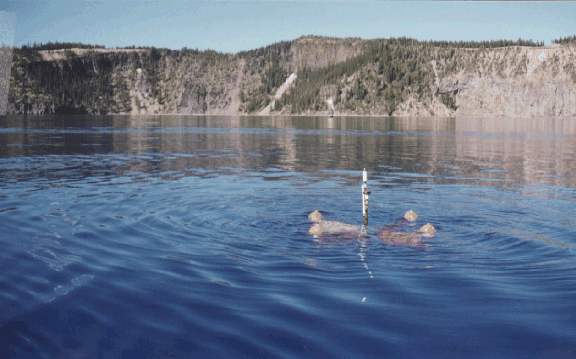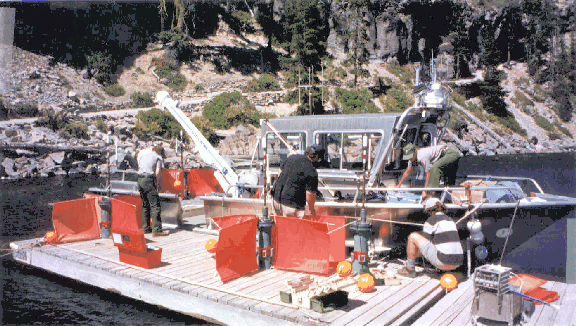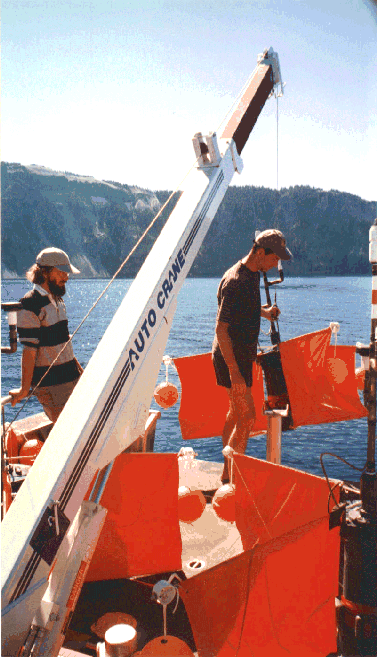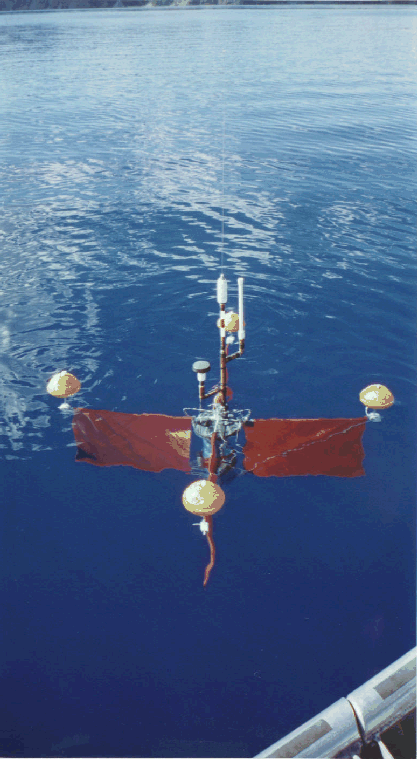Crater Lake Drifter Test – Preliminary Data Report
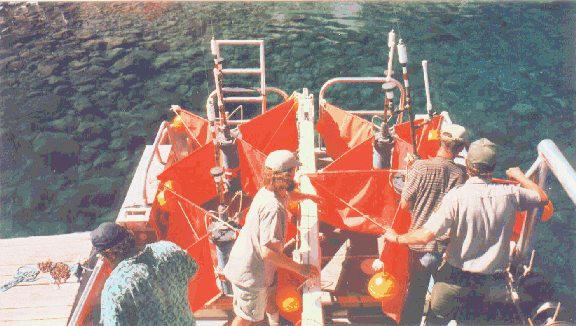
Test dates: 11-13 August 1997
Oregon State University personnel: Jack Barth, Mike Kosro, Stephen Pierce, and Andy Dale
National Park Service Crater Lake Research Team: Scott Girdner, Jeff Milder, and Ashley Gibson
Objectives: Test new Wide Area Differential GPS (WADGPS) surface drifters and examine Crater Lake circulation.
We have implemented WADGPS on a surface drifter. WADGPS is a technique to improve GPS positioning accuracy from +/-100 m to +/- 20 m or better. See Wilson et al. (1996) for technical details. This Crater Lake work was the “full field test” mentioned in the Wilson et al. paper, planned for August 1996 but delayed until August 1997.
T.C. Wilson, J.A. Barth, S.D. Pierce, P.M. Kosro, and B.W. Waldorf, “A Lagrangian drifter with inexpensive wide area differential GPS positioning,” Oceans ’96 MTS/IEEE Conference Proceedings, 2, 851-856, 1996.
Future plans: Plot up wind records (we have these in hand) and interpret drifter motions in terms of simple closed-basin, wind-forced circulation models.
 |
| Figure 1. One drifter tracked over 18 hours with a fix every 5 min. Note improvements in positions and speed estimates using WADGPS. |
 |
| Figure 2. Drifter location and speed vs. time for all four drifters over repeated deployments. Maximum speed observed is ~30 cm/s, surprisingly large. |
 |
| Figure 3. Drifter tracks in eastern half of Crater Lake. Triangles mark deployment locations; marks every half-hour give indication of speed. Note counter-clockwise circulation in eastern basin. |
 |
| Figure 4. Drifter tracks color-coded by speed. Strong southward flow in mid-lake and intermittently strong “ram” current on eastern side. |
Other pages in this section
- Overview of Limnology at Crater Lake Larson 1996
- CL Natural Resource Preservation and Research Fact Sheet 2000
- Breeding Data on Crater Lake Fish – 1933
- Bull Trout Population Edwin Pister 1992
- Bull Trout Restoration and Brook Eradication – Buktenica 1994
- Distribution Bull Trout – Larson – 1995
- Fisheries Investigations in Crater Lake, Oregon, 1937-1940 by Arthur D. Hasler and D. S. Farner
- George Ruhle to Wallis Fish Planting 1951
- Post-Eruptive History and Bathymetry 2002
- Composition of the Water of Crater Lake, by Walton Van Winkle and N. M. Finkbiner, 1913
- Horizontal Distribution and Vertical Migrations of Zooplankton – Owen Hoffman 1969
- Ultraviolet Radiation and Bio-optics in Crater Lake, Oregon, Hargreaves, Girdner, Buktenica, Urbach and Larson, 2005
- The Impact of Climate on the Physics, Hydrology, and Biogeochemistry of Crater Lake, Oregon, July 1999 – June 2004
- Temperature Microstructure in Crater Lake, by Neal, Neshyba, Denner, Limnology and Oceanography, Vol. 16, No. 4 July, 1971
- Representative Freshwater Bacterioplankton Isolated from Crater Lake, Paige, Connon, Giovannoni, 2004
- Ecosystem Analysis Using Modeling, D’Ambrosio, Alterdorf, Jorgensen
- Vertical Temperature Structure in Crater Lake, Oregon (PDF file) by Neal, Neshyba, Denner, Limnology and Oceanography, Vol. 17, No. 3 May, 1972
- Mixing Dynamics in Crater Lake, Crawford, with contributions from Collier, Larson and others 2003
- Whitehorse Pond Limnological and Vascular Plant Study, 1993
- Detecting Long-Term Hydrological Patterns, Peterson, Silsbee, Redmond, Northwest Science, Vol. 73, No. 2, 1999
- Cruise Report, R/V Surf Surveyor Cruise, Mapping the Bathymetry of Crater Lake, Oregon, Gardner, USGS, 2000
- Hydrologic Benchmark Network Stations in the Western U.S. 1963-95, USGS
- Hydrology of Crater, East and Davis Lakes – Phillips 1968
- Horizontal Distribution and Vertical Migrations of Limnetic Zooplankton in Crater Lake, Hoffman 1969
- Crater Lake Limnological Studies Final Report, Larson, McIntire, Jacobs 1993
- Chemical Analyses of Waters from Crater Lake and Nearby Springs, Thompson, White, Nathenson, 1987
- Water balance for Crater Lake, Oregon by Manuel Nathenson, 1991?
- Klamath Network Water Quality Report (Phase II). Hoffman, Currens and Madej., 2005
- Klamath Network Data Mining 2001-2007
- Klamath Network Amphibians and Reptiles Survey 2005
- Temperatures of Springs in the vicinity of Crater Lake, Nathenson, 1990
- Report on the Presence or Absence of Significant Thermal Features Within Crater Lake, 1992
- Hydrothermal Processes in Crater Lake, Oregon – extracted from OSU College of Oceanography Report #90-7, 1991
- Hydrothermal Processes in Crater Lake – Collier 1987
- Interpreting Variations in Secchi Disk Transparencies – Larson – 1980
- First Annual Limnological Report – 1983
- Geochemistry and Phytoplankton Studies – Collier – 1987
*** previous title *** --- *** next title ***




